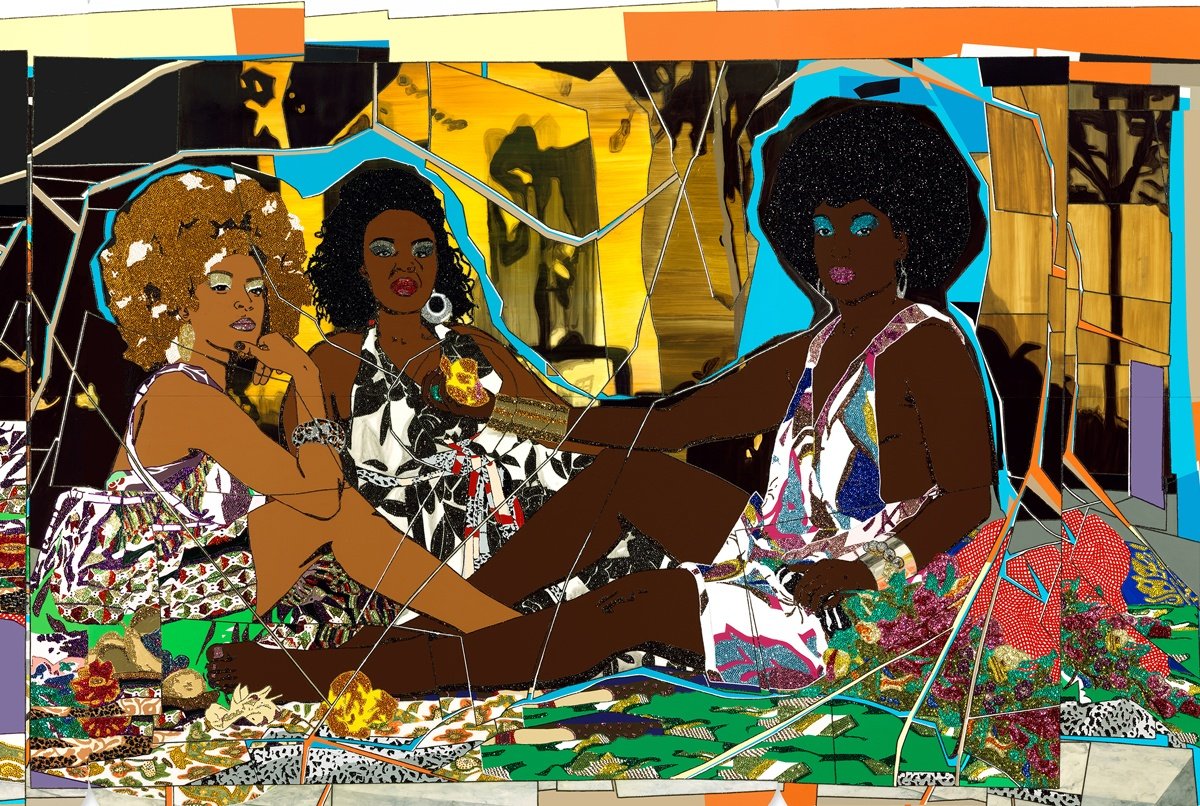Black History Month
Coming a long way from a week to a month, another Black History Month is coming to an end. A month where we learn more about the history behind it, and become more aware of things that are happening to this day. But also a month to celebrate, to uplift black talent and artistry. Over the course of the month we’ve spotlighted four artists that impact very different scenes, showing you the diversity and richness that we love and want to celebrate with you.
Mickalene Thomas
Mickalene Thomas, 'Le Dejeuner sur l’herbe: Les trois femmes noires, 2010, rhinestone, acrylic and enamel on panel
Mickalene Thomas is an American artist who paints black women into art history. As a proud, black, lesbian woman she views black women in a way that goes against the historically male gaze that is dominant throughout art history. Her models are often important black women in her life like her lovers, but also her mother, who she didn’t fully connect with until later in her life. Her portraits are full of art historical references combined with visual nods to 70’s fashion. ‘Le déjeuner sur l’herbe: les trois femmes noires’ is an empowering reïnterpretation of the famous, controversial painting by Edouard Manet. Thomas replaces the two white man and the two nude, white women in the original painting with three black women, fully clothed in colorful patterns and bright makeup. The original painting caused quite a bit of controversy at the time, due to the unpolished sexual themes, which are emphasised by the nude woman in the front looking directly at the viewer. In Thomas’ version, all three women meet the viewer’s gaze, challenging the historically voyeuristic portrayal of women, particularly black women, in art.
Mickalene Thomas, Maya #7, 2015, rhinestones, acrylic and oil on wood panel
Kehinde Wiley
Kehinde Wiley, Willem van Heythuysen, 2005, oil and enamel on canvas, Brooklyn Museum
Perhaps Kehinde Wiley is predominantly known for his presidential portrait of Barack Obama in 2017, as the first black artist to paint the president for the ‘America’s Presidents’ exhibition in the Smithsonian Portrait Gallery. However, instead of famous figures like Obama, Wiley often paints portraits of young black men from his own circles or men he meets in the street. He paints them in an Old Masters tradition, often in a vulnerable manner with colourful floral patterns in the background. In doing this he explores black masculinity and the standards black men are faced with. Simultaneously, much like Mickalene Thomas, Wiley paints black men into the museum, using a visual language that symbolizes wealth and status. Wiley often asks his models to choose an (art)historical figure to represent in his paintings, like St. Sebastian, who has been painted numerous times throughout art history and was eventually picked up by the LGBTQ+ community as a symbol of homoeroticism.
Kehinde Wiley, Morpheus, 2008, oil and enamel on canvas, Seattle Art Museum
Juliana Huxtable
Juliana Huxtable, Untitled (Psychosocial Stuntin’), 2015, inkjet print
Co-founder of Shock Value - a party where every gender or lack thereof is celebrated - Juliana Huxtable's art focuses on exploration of identity. Her afrofuturistic self-portraits are her breakout art as part of the series 'Universal crop tops for all the self canonized saints of becoming'. The series revolves around layering and investigating her own identities on inkjet print, both text and picture form. Huxtable went on to be inspired by language and politics, working those into the exhibition 'Juliana Huxtable' at Project Native Informant. These later works are an exploration into identity as well, weaving darker humor and paranoia into her photographs.
Huxtable moves between genres, employing interdisciplinary works to traverse conventions and countercultures.
Juliana Huxtable, Untitled In The Rage (Nibiru Cataclysm), 2015, inkjet print, Solomon R. Guggenheim Museum, New York
Richard Bruce Nugent
Richard Bruce Nugent, Black Gum, 1928
As the first African-American who openly wrote about his homosexuality, Richard Bruce Nugent made waves with his publication "Smoke, Lilies, and Jade". It's a short story about bisexuality and interracial male desire and was unprecedented at the time. His collected works are considered "the missing piece of the jigsaw puzzle that comprise black history in the 20th century" (A. Glassman, Gay People's Chronicle).
A lot of his later works include biblical imagery coupled with themes of homosexuality as can be seen on slide 5 and 6. Nugen was a prominent member of the Harlem Renaissance, less so in his own art and more as an aid to other artists.
Thanks to his art resurfacing in 1983 in 'Black Men/White Men: A Gay Anthology' we gained a new insight into the lifestyle of black gay artists dring the Harlem Renaissance that we would not have without him.
Richard Bruce Nugent, The Model, ca. 1950-55, oil on canvas board








